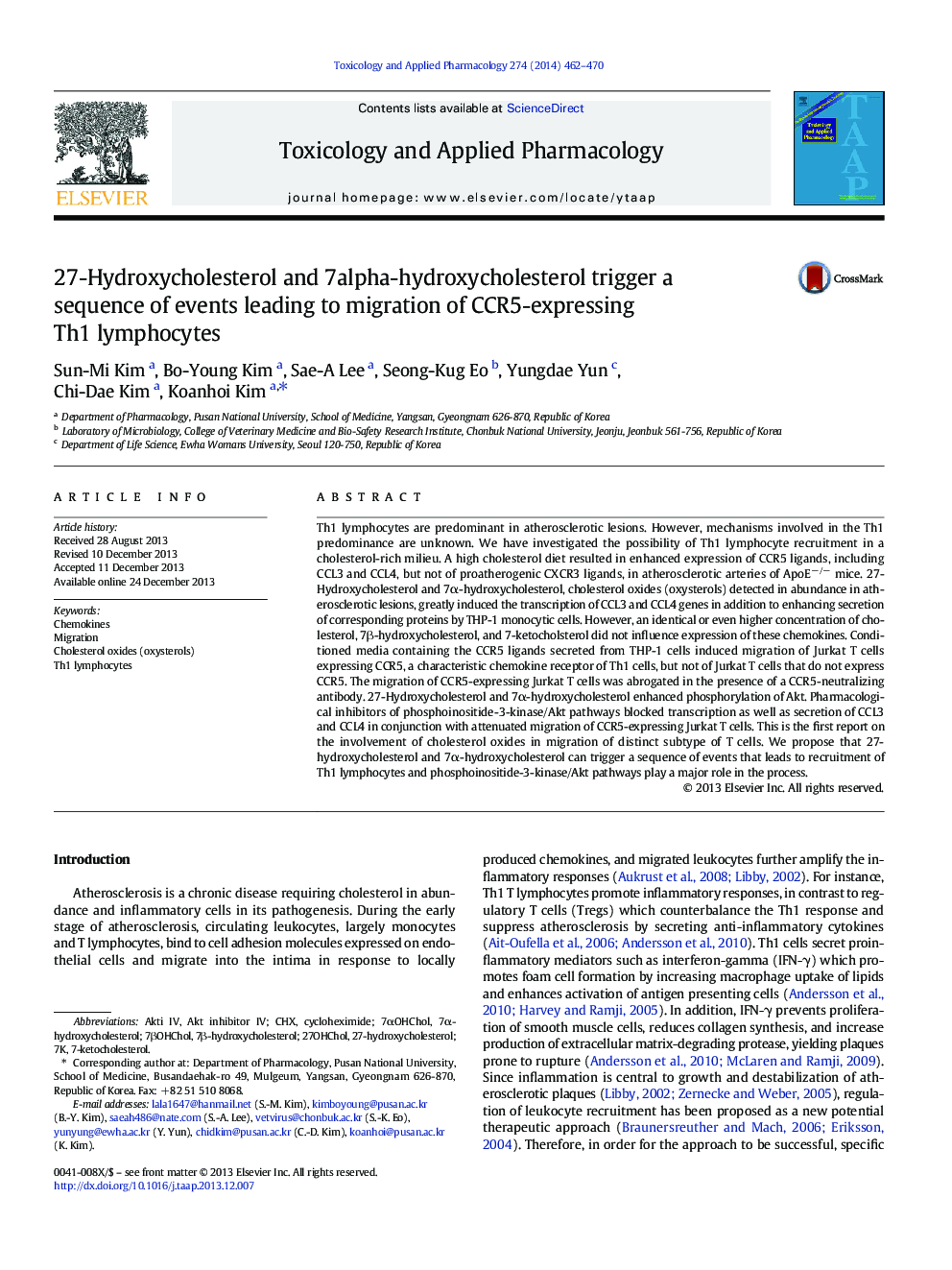| کد مقاله | کد نشریه | سال انتشار | مقاله انگلیسی | نسخه تمام متن |
|---|---|---|---|---|
| 5846266 | 1128470 | 2014 | 9 صفحه PDF | دانلود رایگان |

- High-cholesterol diet induces CCR5L expression, like CCL3 and CCL4, in ApoEâ/â mice.
- 27OHChol and 7αOHChol enhance secretion of CCL3 and CCL4 by monocytic cells.
- The secreted CCR5 ligands promote migration of CCR5-expressing Th1 cells.
- We report a mechanism underlying Th1 cell recruitment into atherosclerotic lesions.
Th1 lymphocytes are predominant in atherosclerotic lesions. However, mechanisms involved in the Th1 predominance are unknown. We have investigated the possibility of Th1 lymphocyte recruitment in a cholesterol-rich milieu. A high cholesterol diet resulted in enhanced expression of CCR5 ligands, including CCL3 and CCL4, but not of proatherogenic CXCR3 ligands, in atherosclerotic arteries of ApoEâ/â mice. 27-Hydroxycholesterol and 7α-hydroxycholesterol, cholesterol oxides (oxysterols) detected in abundance in atherosclerotic lesions, greatly induced the transcription of CCL3 and CCL4 genes in addition to enhancing secretion of corresponding proteins by THP-1 monocytic cells. However, an identical or even higher concentration of cholesterol, 7β-hydroxycholesterol, and 7-ketocholsterol did not influence expression of these chemokines. Conditioned media containing the CCR5 ligands secreted from THP-1 cells induced migration of Jurkat T cells expressing CCR5, a characteristic chemokine receptor of Th1 cells, but not of Jurkat T cells that do not express CCR5. The migration of CCR5-expressing Jurkat T cells was abrogated in the presence of a CCR5-neutralizing antibody. 27-Hydroxycholesterol and 7α-hydroxycholesterol enhanced phosphorylation of Akt. Pharmacological inhibitors of phosphoinositide-3-kinase/Akt pathways blocked transcription as well as secretion of CCL3 and CCL4 in conjunction with attenuated migration of CCR5-expressing Jurkat T cells. This is the first report on the involvement of cholesterol oxides in migration of distinct subtype of T cells. We propose that 27-hydroxycholesterol and 7α-hydroxycholesterol can trigger a sequence of events that leads to recruitment of Th1 lymphocytes and phosphoinositide-3-kinase/Akt pathways play a major role in the process.
Th1 lymphocytes are predominant in atherosclerotic lesions. However, mechanisms involved in the Th1 predominance are unknown. We have investigated the possibility of Th1 lymphocyte recruitment in a cholesterol-rich milieu. We propose a model via which 27OHChol and 7αOHChol contribute to the predominance of Th1 cells in atherosclerotic lesions on the basis of our results and previous findings. Cholesterol deposited in the artery undergoes oxidative modification to oxysterols. Exposure of monocytic cells to 27OHChol or 7αOHChol results in increased transcription and secretion of CCR5 ligands, like CCL3 and CCL4, which leads to a concentration gradient of the chemokines. Among the lymphocytes attached to cell adhesion molecules expressed on endothelial cells, Th1 cells that express CCR5 recognize the gradient and follow the signal of increasing chemokine concentration towards the source of the chemokines, whereas other subtypes of T cells that do not express CCR5 (Tregs and Th2 cells) do not respond. The preferential infiltration of Th1 cells leads to predominance of Th1 cells. Since oxidized LDL (oxLDL) enhances the expression of cell adhesion molecules on endothelial cells, existence of oxLDL will accelerate the recruitment of Th1 lymphocytes into atherosclerotic lesions in response to the oxysterols.91
Journal: Toxicology and Applied Pharmacology - Volume 274, Issue 3, 1 February 2014, Pages 462-470